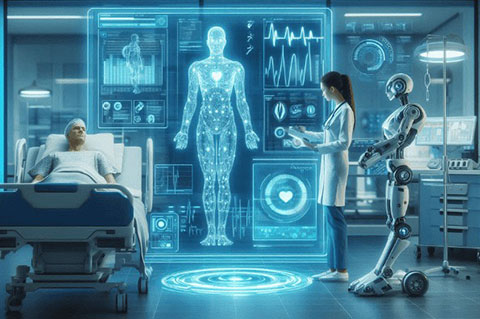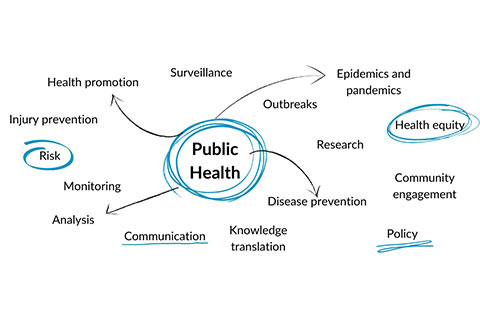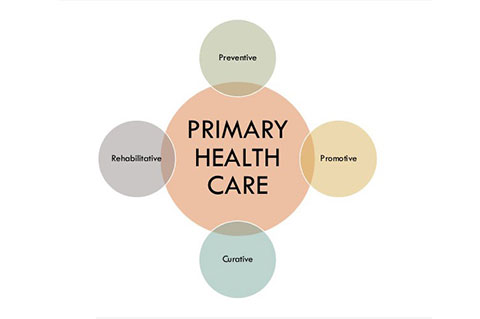In 2025, the Indian health care industry stands at a crossroads. Reforms by the government, technology, and a demand for universal care are bringing a drastic paradigm shift to the business. These are AI and nanotechnology in diagnostics, enhanced digital health platforms, and enhanced insurance coverage. These shifts not only lead to the way health care is being delivered but also the way it is being viewed in one of the world’s most populous nations.
Let’s take a look at the significant trends and innovations transforming India’s healthcare sector this year.

1. Artificial Intelligence: Revolutionizing Early Diagnosis and Treatment
Artificial Intelligence (AI) is going to be an extremely powerful tool for Indian health care. Telangana began a new pilot program in three districts for applying AI to cancer routine screenings. It targets oral, breast, and cervical cancers. The program integrates high-resolution scans with AI-based software to detect issues early, particularly in rural and poor areas where there are hardly any specialist physicians.
The initiative is being spearheaded by the MNJ Cancer Institute and, if it takes off, will be implemented in state medical colleges. Daycare screening centers in the district level are also in the pipeline, with the hope of checking cancer in its earliest and most treatable form. In a country where cancer is one of the leading causes of death, the strategy has the potential to save thousands of lives and reduce healthcare expenses in the long run.

2. Pharma Boom: Low-Cost Generics and Innovation Boom in India
India’s domestic pharma industry recorded a 7.8% growth for the same period last year in April 2025. That shows growth and resilience. The growth is spurred by positive government policies, heightened global demand, and local research and production improvement.
One of the major trends to follow is the looming expiration of the patents on drugs such as semaglutide. It is the active ingredient in blockbuster diabetes and weight-loss medications Ozempic and Wegovy. Indian pharmaceutical companies such as Biocon, Cipla, Dr. Reddy’s, and Lupin are poised to launch generic forms of these medications. That would significantly reduce the price and benefit millions of obese and type 2 diabetics.

3. Digital Health Infrastructure: Linking Patients, Doctors, and Systems
The drive towards digitization is a large trend in 2025. The government of India introduced a new Health Management Information System (HMIS) under the Central Government Health Scheme (CGHS). The new electronic platform comes in place of legacy systems, allowing government officials and their dependents to make payments, schedule appointments, and access records through an intuitive interface.
It’s not convenience—it’s data-driven care, greater transparency, and business efficiency in public health facilities.
Concurrently, the Ayushman Bharat Digital Mission (ABDM) is expanding, connecting India’s private and public health records. It provides patients with a digital health ID, monitors medical histories, and ensures that care doesn’t leave them, regardless of where they receive treatment. Telemedicine being now the standard, this digital health system is critical to the establishment of an integrated healthcare system that is comprehensive, accessible, and inclusive.

4. Public Health Priorities: Disease Prevention and Inclusive Policies
In 2025, there is a renewed focus on preventing disease, precisely because diseases transmitted by insects are on the rise in the majority of Indian states. In Madhya Pradesh, to take example, more than 100 cases of dengue and chikungunya were reported in the very first quarter of the year. These diseases flourish because of a lack of sanitation and waterlogging, which identify the requirements of improved city planning and greater public education.
Health departments are stepping up monitoring and campaigns against the problem. They are also shifting towards more dynamic welfare initiatives. Madhya Pradesh has declared that all officials of the state government will be insured under a health insurance scheme. It is an important move to provide economic assistance and access to good-quality healthcare to government employees in the public sector.

5. Building Primary Healthcare: Investing in the Foundation
No health system can function properly without proper primary care. Bearing this fact in mind, the Tamil Nadu government has consented to investing an additional ₹1.47 crore in the Aruldaspuram Urban Primary Health Centre (UPHC) in Madurai. The addition will provide additional space for additional patients, alleviate the congestion in the health centre, and enhance the availability of curative and preventive care.
The plan is part of a bigger initiative to upgrade some UPHCs and establish new urban health centers that will specialize in women’s health care, chronic disease management, and nutrition care. The centers are meant to relieve the workload of big hospitals and provide more accessible medical care to the people, particularly among marginalized communities.

6. Looking Ahead: Challenges and Opportunities
Even with the good news, India’s health system remains with huge problems. It lacks sufficiently trained health workers, particularly in rural areas, and most lack equal access to high-tech treatment. Furthermore, the ability to afford treatment is a significant problem, particularly for costly surgery, procedures, and brand-name drugs.
Today, with the government placing greater focus on public-private partnerships, digital health investments, and stimulating local research on drugs, India is better positioned than ever to achieve these objectives.
Conclusion: A Healthier, Smarter, More Inclusive Future
2025 will be recalled as a watershed year for Indian healthcare. Momentum build-up—spanning AI milestones, digitalization, drug expansion, and expanding public health initiatives—holds out not just reform, but revolution. For patients, it will result in improved diagnosis, faster access, and reduced costs. For providers and policymakers, it is an opportunity to rebuild trust, enhance infrastructure, and meet the vision of “health for all.




